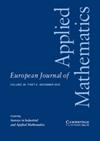关于可压缩湍流中特征函数层次的Lie对称性
IF 1.1
4区 数学
Q1 MATHEMATICS, APPLIED
引用次数: 0
摘要
我们计算了可压缩湍流特征函数(CF)层次的李氏对称性,忽略了粘度和导热性的影响。在概率密度函数(PDF)层次结构中,观察到典型的非局部性质,而在CF层次结构中自然消除了非局部性质。我们观察到CF层次保留了所有可压缩欧拉方程所满足的对称性。广义地说,在CF层次中可以识别出四种对称类型:(i)对应于坐标系不变性的对称,(ii)缩放/扩张群,(iii)投影群和(iv)统计对称,后者定义了间歇性和非高斯性的度量。由于多点CFs需要满足约化条件等附加约束,因此投影对称性只对单原子气体有效,即比热比$\gamma = 5/3$。由于叠加原理,CF层次的线性导致统计对称性。对于所有的对称,还给出了CF的全局变换和各种关键可压缩统计量。本文章由计算机程序翻译,如有差异,请以英文原文为准。
On the Lie symmetries of characteristic function hierarchy in compressible turbulence
We compute the Lie symmetries of characteristic function (CF) hierarchy of compressible turbulence, ignoring the effects of viscosity and heat conductivity. In the probability density function (PDF) hierarchy, a typical non-local nature is observed, which is naturally eliminated in the CF hierarchy. We observe that the CF hierarchy retains all the symmetries satisfied by compressible Euler equations. Broadly speaking, four types of symmetries can be discerned in the CF hierarchy: (i) symmetries corresponding to coordinate system invariance, (ii) scaling/dilation groups, (iii) projective groups and (iv) statistical symmetries, where the latter define measures of intermittency and non-gaussianity. As the multi-point CFs need to satisfy additional constraints such as the reduction condition, the projective symmetries are only valid for monatomic gases, that is, the specific heat ratio,
$\gamma = 5/3$
. The linearity of the CF hierarchy results in the statistical symmetries due to the superposition principle. For all of the symmetries, the global transformations of the CF and various key compressible statistics are also presented.
求助全文
通过发布文献求助,成功后即可免费获取论文全文。
去求助
来源期刊
CiteScore
4.70
自引率
0.00%
发文量
31
审稿时长
>12 weeks
期刊介绍:
Since 2008 EJAM surveys have been expanded to cover Applied and Industrial Mathematics. Coverage of the journal has been strengthened in probabilistic applications, while still focusing on those areas of applied mathematics inspired by real-world applications, and at the same time fostering the development of theoretical methods with a broad range of applicability. Survey papers contain reviews of emerging areas of mathematics, either in core areas or with relevance to users in industry and other disciplines. Research papers may be in any area of applied mathematics, with special emphasis on new mathematical ideas, relevant to modelling and analysis in modern science and technology, and the development of interesting mathematical methods of wide applicability.

 求助内容:
求助内容: 应助结果提醒方式:
应助结果提醒方式:


